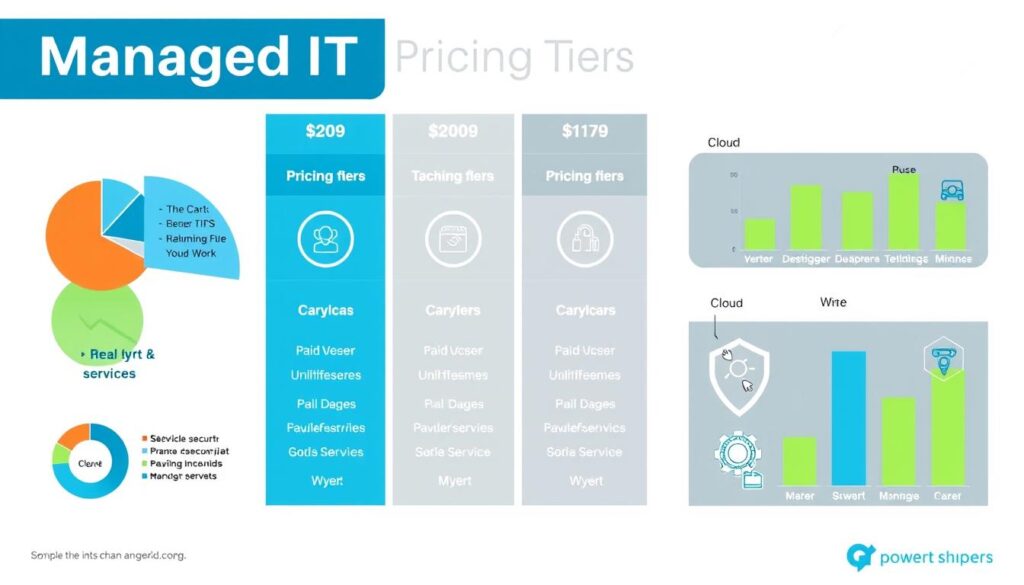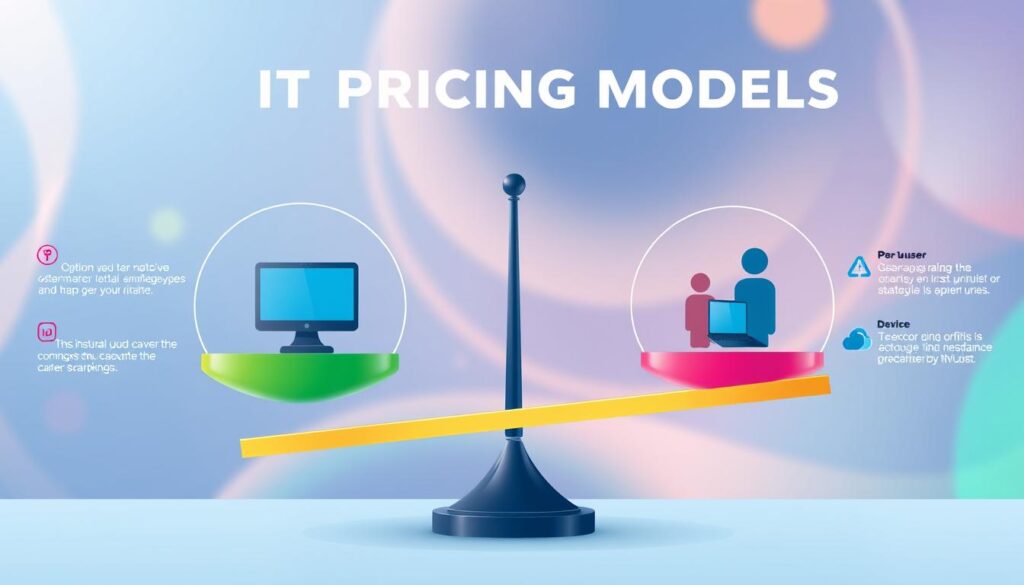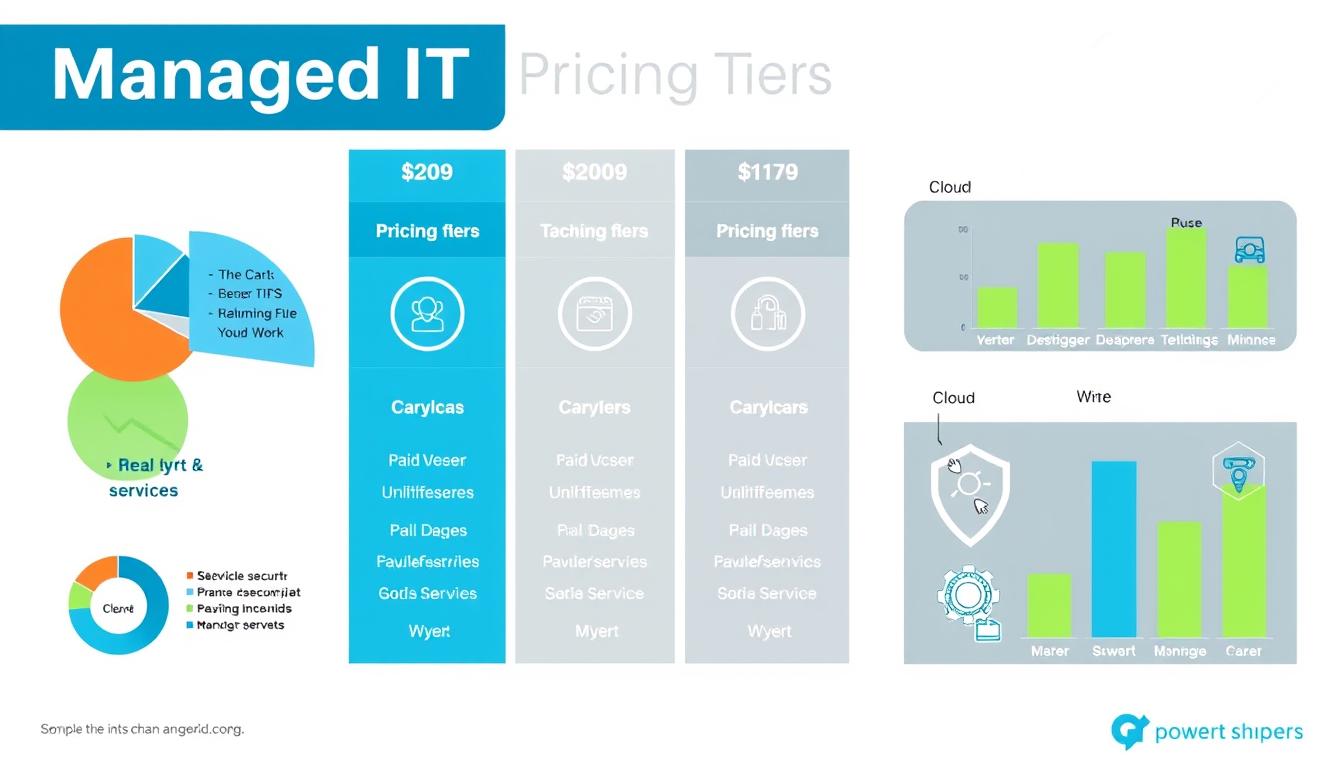Businesses today face a lot of competition in the digital world. They need reliable and affordable IT support. Managed IT services are a great solution, letting companies outsource their IT needs to experts.
This guide will dive into managed IT services pricing. We’ll cover what affects the cost, the different pricing models, and how to pick the right provider for your budget. It doesn’t matter if you’re a small business or a big company. This guide will help you make smart choices about your IT support.

Key Takeaways
- Managed IT services offer many benefits, like saving money, boosting productivity, and better security.
- The cost of managed IT services can change a lot. It depends on things like company size, what you need for your infrastructure, and how complex your technology is.
- Knowing the different pricing models, like per-user and per-device, helps you choose the best option for your business.
- It’s important to think about the potential return on investment and long-term savings when picking a managed IT service provider.
- Looking closely at what providers offer, their service agreements, and contract terms is key to finding the right fit for your budget.
Understanding Managed IT Services: A Comprehensive Overview
Managed IT services have changed the game for businesses of all sizes. They offer a wide range of IT services that are handled by experts. This lets companies focus on what they do best while their tech is taken care of.
Core Components of Managed IT Support
Managed IT services have key parts that keep a company’s IT running smoothly and securely. This includes constant network watching, strong cybersecurity, and reliable help desk support. These help solve any tech problems quickly.
Benefits of Outsourcing IT Management
Outsourcing IT management brings many benefits. Companies save money, get access to IT experts, and can focus more on their main work. They also get to adjust their IT needs easily. Features like proactive maintenance and set monthly costs make outsourced IT even more valuable.
“Managed IT services have become an essential part of modern business operations, empowering organizations to leverage the latest technology while minimizing the burden of IT management.”
How Much Does Managed IT Services Cost: Breaking Down the Pricing
Managed IT services pricing varies a lot. It depends on your business size and technology complexity. We’ll explore typical rates and how they’re structured.
Managed IT Pricing Structure
The main pricing models are:
- Per-user pricing: This is based on the number of employees. Costs range from $50 to $200 per user, per month.
- Per-device pricing: This is for the number of devices managed. Costs range from $75 to $300 per device, per month.
- Tiered pricing: This model offers lower rates as the number of users or devices grows.
Managed IT providers may also charge extra for services like project work or 24/7 helpdesk. It’s key to review all costs to understand your total investment.
| Service Level | Per-User Pricing | Per-Device Pricing |
|---|---|---|
| Basic Support | $50 – $100 per user/month | $75 – $150 per device/month |
| Premium Support | $100 – $200 per user/month | $150 – $300 per device/month |
| Enterprise-Level | $150 – $300 per user/month | $250 – $500 per device/month |
Keep in mind, these are general ranges. Your actual managed IT pricing structure and IT service rates will depend on your specific cost breakdown and needs.
“The key to finding the right managed IT service provider is to understand your specific needs and how they align with the pricing models and service levels offered.”
Factors Influencing Managed IT Service Pricing
Several key factors affect the cost of managed IT services. Knowing these elements helps estimate costs and choose the best service for your business.
Company Size and Infrastructure Requirements
The size of your company and your tech setup are big factors in pricing. Larger companies need more support, which costs more. Smaller businesses with simple IT needs might find cheaper options.
Service Level Agreements and Response Times
Your service level agreement (SLA) also plays a role. Faster fixes and 24/7 support cost more. But, finding the right balance between cost and support is possible.
Technology Stack Complexity
The complexity of your tech setup is another factor. Companies with many different systems need more help, which costs more. But, simpler setups might be cheaper to manage.
| IT Pricing Factor | Impact on Managed IT Service Costs |
|---|---|
| Company Size | Larger companies with more extensive IT needs typically pay higher service fees. |
| Service Level Agreements (SLAs) | Businesses requiring faster response times and 24/7 support can expect to pay premium prices. |
| Technology Stack Complexity | Diverse and sophisticated IT environments often require more specialized expertise, leading to higher costs. |
Understanding these IT pricing factors helps businesses estimate costs. This way, they can make choices that fit their budget and IT needs.
Per-User vs. Per-Device Pricing Models
Businesses face a choice between IT pricing models: per-user and per-device pricing. Knowing the differences helps companies pick the best fit for their IT needs and budget.
Per-User IT Costs are based on the number of users. This model works well for companies with a steady number of employees. But, it might not be the best for businesses with a lot of employees or changing IT needs.
Per-Device Pricing focuses on the number of devices needing IT support. It’s good for companies with many different devices. But, managing and budgeting for more devices can get complicated.
| Pricing Model | Pros | Cons |
|---|---|---|
| Per-User | Predictable and easier to budget Suitable for stable workforce | Less cost-effective for fluctuating workforce May not scale well for large user counts |
| Per-Device | Tailored support for diverse technology Scalable as the number of devices grows | More complex to manage and budget May be less suitable for stable workforce |
Choosing between per-user and per-device pricing models depends on a company’s specific needs. By weighing the pros and cons, businesses can find the best way to manage their IT costs and technology.

Common Managed IT Service Packages and Their Price Ranges
Businesses have many options for managed IT services, each fitting different needs and budgets. These options include basic support, premium service tiers, and enterprise-level solutions. Knowing what each offers can help businesses pick the right IT service packages for them.
Basic Support Package Features
The basic tiered IT support packages offer key services like remote monitoring and helpdesk support. They start at about $50 to $100 per user per month. This makes them a good choice for small businesses or those with simple IT needs.
Premium Service Tier Options
Premium service tiers have more features for businesses with bigger IT service packages needs. They include on-site visits, 24/7 monitoring, and advanced security. Prices range from $100 to $200 per user per month.
Enterprise-Level Solutions
Enterprise IT solutions are the most comprehensive for large organizations. They offer dedicated management and custom infrastructure design. Pricing starts at $200 per user per month, based on specific needs.
Knowing the features and prices of these packages helps businesses choose wisely. They can pick the IT service packages that match their budget and needs.
Hidden Costs and Additional Expenses to Consider
When planning for managed IT services, remember it’s not just the monthly fee. Hidden costs and extra expenses can greatly affect your total cost. It’s important to consider these when budgeting for your business.
One hidden cost is onboarding and setup fees. These can be a few hundred to several thousand dollars. They depend on how complex your IT setup is. You might also need to buy new hardware or software to work with the service.
Another cost to watch out for is scalability fees. As your business grows, so do your IT needs. Your provider might raise their fees for more users, devices, or storage. Knowing about these fees ahead of time helps you budget for future costs.
| Hidden Cost | Description | Potential Cost Range |
|---|---|---|
| Onboarding and Setup Fees | Charges for initial deployment and integration of managed IT services | $500 – $5,000+ |
| Hardware and Software Costs | New equipment or licenses required to use the managed service | Varies depending on specific needs |
| Scalability Charges | Increased fees for growing IT requirements, such as more users or devices | $10 – $50 per user/device per month |
Knowing about IT service hidden costs and additional IT expenses helps you plan better. This way, you can avoid any surprise costs in the future.

ROI and Cost Savings from Managed IT Services
Investing in managed IT services can bring big financial wins for businesses. By handing over your IT management, you can see IT service ROI grow. This is thanks to less downtime, better productivity, and lower IT costs compared to having an in-house team.
Long-term Financial Benefits
One key benefit of managed IT cost savings is cutting down on IT expenses. Managed service providers offer top-notch IT support at a lower cost than an in-house team. This means less money spent on hardware, software, maintenance, and repairs.
Productivity Improvements
Handing over your IT to a trusted provider can also boost IT productivity gains. With a reliable IT setup, managed services keep your tech running smoothly. This lets your team focus on their main tasks, leading to better work and business results.
“The cost savings and productivity gains from managed IT services have been a game-changer for our business. We’ve been able to redirect resources to strategic initiatives and achieve a much higher ROI on our technology investments.”
Selecting the Right Managed IT Service Provider Within Your Budget
Finding the right managed IT service provider is key for your business. It’s important to balance quality service with cost. By asking the right questions and understanding contract terms, you can get the best value.
Essential Questions to Ask Providers
Start by checking the provider’s experience, expertise, and references. Ask about their service level agreements, response times, and technology use. Make sure their security, data backup, and disaster recovery plans meet your needs.
Contract Terms and Flexibility
Review contract terms carefully for flexibility. Look for providers who can adjust services and pricing to fit your IT needs and budget. Negotiate contract length, service levels, and the ability to scale up or down as needed.
FAQ
What is the typical cost range for managed IT services?
Managed IT services cost varies a lot. It depends on your company size, service level, and tech setup. Prices usually fall between $50 to $300 per user monthly, or $100 to $500 per device monthly.
What are the core components of managed IT support?
Managed IT services cover many areas. They include network monitoring, cybersecurity, and help desk support. Also, software management, cloud services, and IT planning are part of it.
What are the key benefits of outsourcing IT management?
Outsourcing IT has many benefits. It saves money, gives you expert support, and lets you focus on your business. It also boosts productivity and keeps your data safe.
How do per-user and per-device pricing models differ?
Per-user pricing is based on employees. Per-device pricing is for the devices managed. Per-user is cheaper for big teams. Per-device is better for lots of devices.
What are some common managed IT service packages and their price ranges?
There are different IT service packages. Basic support costs around $50-$150 per user/device monthly. Premium services are $150-$300, and enterprise solutions are $300-$500. Each offers more features and support.
What hidden costs and additional expenses should I consider when budgeting for managed IT services?
Besides the main fees, think about onboarding costs and hardware expenses. Also, consider scalability charges and any extra services that might cost more.
How can I determine the ROI and cost savings of managed IT services?
Managed IT services can save you money in the long run. They reduce downtime, boost productivity, and cut IT costs. The savings depend on your business needs and the provider.
What are the essential factors to consider when selecting a managed IT service provider within my budget?
When picking a provider, look at their technical skills and customer service. Also, consider the contract terms, pricing, and how well they meet your business needs. Ask questions and negotiate to get the best deal.



